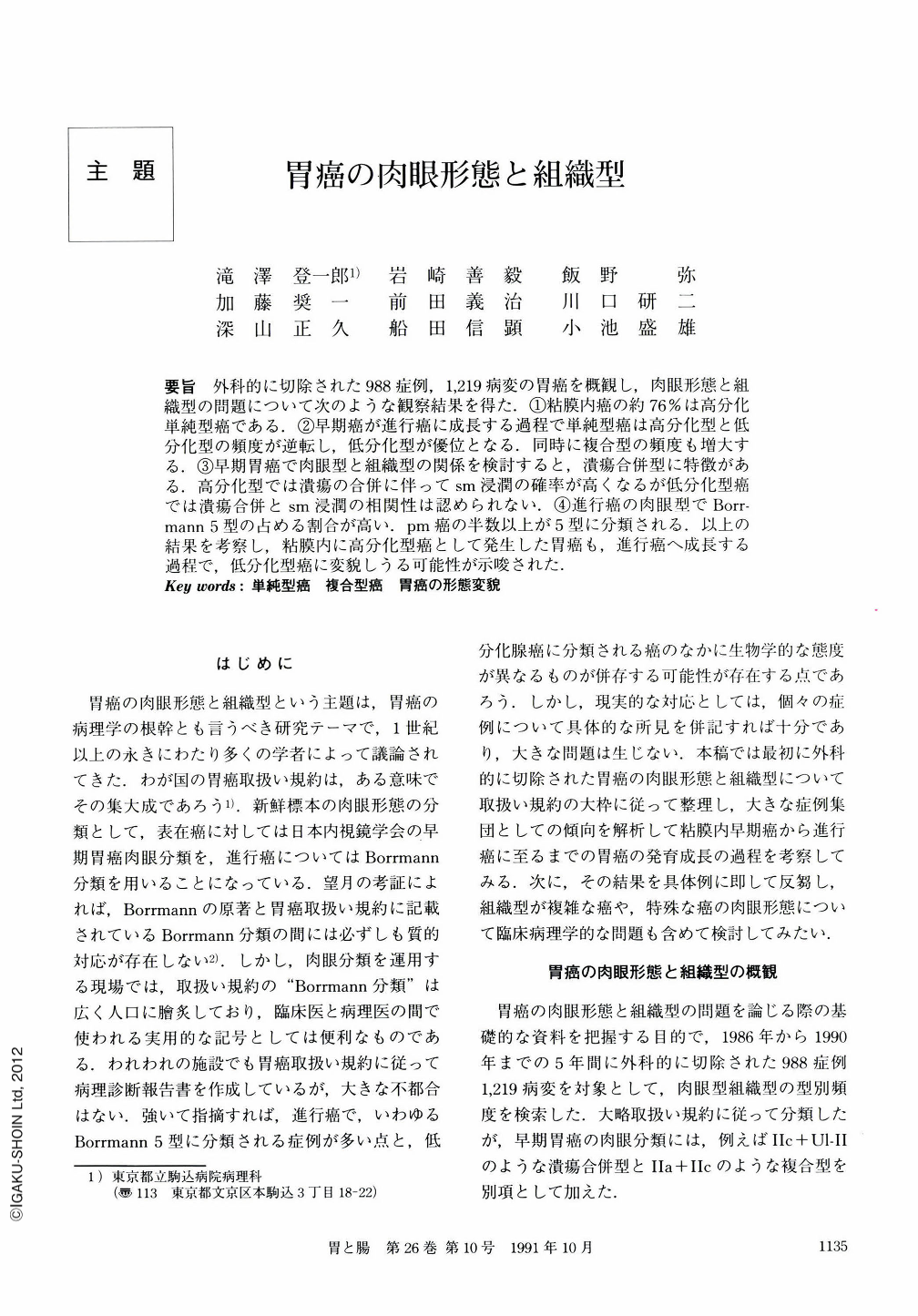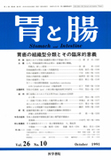Japanese
English
- 有料閲覧
- Abstract 文献概要
- 1ページ目 Look Inside
- サイト内被引用 Cited by
要旨 外科的に切除された988症例,1,219病変の胃癌を概観し,肉眼形態と組織型の問題について次のような観察結果を得た.①粘膜内癌の約76%は高分化単純型癌である.①早期癌が進行癌に成長する過程で単純型癌は高分化型と低分化型の頻度が逆転し,低分化型が優位となる.同時に複合型の頻度も増大する.①早期胃癌で肉眼型と組織型の関係を検討すると,潰瘍合併型に特徴がある.高分化型では潰瘍の合併に伴ってsm浸潤の確率が高くなるが低分化型癌では潰瘍合併とsm浸潤の相関性は認められない.①進行癌の肉眼型でBorr mann 5型の占める割合が高い.pm癌の半数以上が5型に分類される.以上の結果を考察し,粘膜内に高分化型癌として発生した胃癌も,進行癌へ成長する過程で,低分化型癌に変貌しうる可能性が示唆された.
Surgical pathology reports of gastric cancer, in accordance with the general rules for the gastric cancer study edited by Japanese Research Society for Gastric Cancer, were made for 988 cases at our department in 1986 through 1990. Review of those reports allowed us to count gastric cancers based on macro-and microscopic classifications and to analyse the relationship between macroscopic findings and microscopic features.
Modified macroscopic classification by Japan Gastroenterological Endoscopy Society was used for early gastric cancer, and Borrmann-classification for advanced cancer. Histology of gastric cancer was divided into two major groups, i.e., well and poorly differentiated adenocarcinomas, and, furthermore, subclassified into simplex and composite types, respectively. For examples, a case composed of pap>tub1>tub2 is classified into well differentiated simplex type, a case of por>sig is poorly differentiated simplex type. On the other hand, composite type is the one in which coexistence of well and poorly differentiated adenocarcinoma is verifled. For examples, a case of pap>tub1>por>sig is classified into well differentiated composite type and a case of por>sig>pap is poorly differentiated composite type.
The results and discussion are summarized as follows:
1) Approximately 76% of early mucosal cancers are classified into well differentiated simplex type and 21% poorly differentiated simplex type. Mucosal cancer of composite type is very rare.
2) Comparison of the histology of advanced cancers with that of early cancers shows that poorly differentiated simplex type exceeds well differentiated simplex type in frequency; approximately 51% are poorly differentiated, though only 22% are well differentiated.
3) From early to advanced, the frequency of composite type gradually increases.
4) Such differences in histology between early and advanced cancers may be related to the possibility that considerable number of cases originating as well differentiated simplex type change to poorly differentiated in the course of growth from mucosal to advanced cancer.
5) Macroscopic classification of well and poorly differentiated early cancers of simplex type yields the following interesting fact regarding the presence of ulcer and/or ulcer-scar. In well differentiated cancers, association of ulcer or ulcer-scar may suggest the presence of submucosal invasion, though there is no such correlation between submucosal invasion and ulcer or ulcer-scar in poorly differentiated cancers.
6) Macroscopic classification of advanced cancers reveals unexpectedly high frequency of Borrmann-5; unclassified. With respect to Borrmann-5, it is important to describe the reasons why it is pathologically unclassified. More than 50% of pm-cancers are classified as Borrmann-5.

Copyright © 1991, Igaku-Shoin Ltd. All rights reserved.


